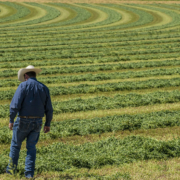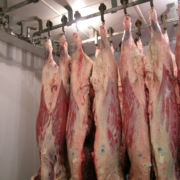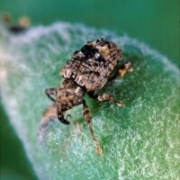Understanding the COMET-Planner Tool
 Print This Post
Print This Post
By Cody Brown and Darron Gaus, NCAT Agriculture Specialists
Carbon Farm Planning is a rewarding process for producers and conservation planners, as we “dig deep” and find all the potential carbon sinks and soil health practices that can be implemented across the landscape. Alongside great partners like Carbon Cycle Institute, we have developed a resilience planning framework to allow more farmers and ranchers here in Texas access to this holistic approach. You can take a deeper dive into the first Carbon Farm Plans in Texas here. One of the first questions producers ask during the planning process is, “If I implement all these practices, how much carbon emissions could I be offsetting?” To answer that question, we use a tool called COMET-Planner.
Introduction
COMET-Planner is a web-based greenhouse gas (GHG) evaluation tool used to provide modelled estimates of the greenhouse gas impacts of certain conservation practices utilized across various agricultural landscapes. Designed by Colorado State University, in partnership with the U.S. Department of Agriculture (USDA) and the Natural Resource Conservation Service (NRCS), this tool is intended for initial farm and/or ranch conservation planning purposes and is now available in the contiguous United States.
First launched in 2015, and just recently updated in 2023, COMET-Planner is designed around the NRCS Conservation Practice Standards (CPS) and is thus most applicable for agricultural land-management decision-making processes. There are currently five major NRCS Conservation Practice categories evaluated in COMET-Planner:
- Cropland Management
- Grazing Lands
- Cropland to Herbaceous Cover
- Restoration of Disturbed Lands
- Woody Plantings
How are the carbon sequestration GHG reduction estimates calculated?
“Carbon sequestration and GHG emission reductions estimates compare adoption of a conservation practice to a baseline practice. Conservation scenarios were evaluated in COMET-Farm, which utilizes the USDA entity-scale greenhouse gas inventory methods, and estimates were generalized by multi-county regions defined by USDA MLRAs. COMET-Planner estimates represent field activities only, including those associated with soils and woody biomass as appropriate, and do not include off-site emissions, such as those from transportation, manufacturing, processing, etc.”
Source: COMET-Planner
The need for conservation planners to access quick, easy-to-use tools that assess the greenhouse gas impacts of conservation practices implemented on farms was a driving factor in development of the COMET-Planner tool. The nature of the work requires conservation planners to assess a range of environmental, agronomic, and economic factors before suggesting a conservation practice. Thus, COMET-Planner has become the nationally adopted tool for conservation planners to utilize for incorporating greenhouse gas impacts into their planning process.
Implications
As we, conservation planners at NCAT, help more farmers and ranchers through the process of climate-smart agriculture practices, we have become familiar with COMET-Planner. The user interface is quite easy to navigate, but there are a few tricks and tips we have learned along the way. A model is, well, a model, and sometimes that model doesn’t scale to small acreage very well. We have been able to enter whole numbers like 100 to find scalable indexes for the small-scale operations. For example, if you want to know how much CO2 equivalent will be sequestered for cover cropping one acre in Travis County, Texas, entering 1 acre in the model will yield zero. But if you enter 100 into the model you will see it is 27 tonnes. This means that one acre of cover crop on irrigated farmland with a 25% reduction in nitrogen fertilizer will sequester 0.27 tonnes per year, not zero.
Also, all models need input data to build from, so quite often while using COMET-Planner, we come across counties with no equivalents for certain practices. For most practices, you can mix and match other practices to produce a best-guess scenario of possible impact you can have on sequestration of carbon into your soil. As more producers adopt these practices, the model will only get more accurate over time.
Impact and Importance
Harmful levels of carbon dioxide are building up in the atmosphere and changing our climate. As global average temperatures continue to rise, agricultural producers find themselves on the front lines of this struggle. Extreme weather events and evolving climate cycles require farmers to rapidly adapt to “weather the storm.” At the same time, agricultural lands have tremendous potential to capture and store heat-trapping carbon dioxide in healthy soils and agroecosystems.
As the way the world often goes across most industries, economic and financial data tend to drive the decision-making process; this is likely an inherent trait of a capitalist economy. However, this proposes a unique challenge to the agricultural industry: how to quantify the economic value of healthy soils or the lack thereof? There is an apparent need and value to quantifying and tracking the GHG impacts of adopting farming and ranching practices that increase the health of soil:
- To justify financially supporting the adoption of conservation farming and ranching practices at a national level
- To bolster adoption rates in efforts to substantially re-carbonize our agricultural working lands, reduce the soil carbon debt and rebuild resilience
Through COMET-Planner effectively estimating the GHG impact of adopting these agricultural practices, we can begin to associate an economic and environmental value to supporting practices that help build healthy soils. This empowers farmers, ranchers, and technical assistance providers across the United States to make informed decisions about land management practices and the GHG impacts thereof.
Related ATTRA Resources
Other Resources
Climate- Smart Agriculture and Forestry (CSAF) Mitigation Activities List for FY2024
COMET-Planner Companion Report/Guide
Soil Carbon Debt of 12,000 Years of Human Land Use
This blog is produced by the National Center for Appropriate Technology through the ATTRA Sustainable Agriculture program, under a cooperative agreement with USDA Rural Development. ATTRA.NCAT.ORG.

 USDA Photo by Preston Keres
USDA Photo by Preston Keres
 Photo: Arion Thiboumery
Photo: Arion Thiboumery




 NCAT
NCAT
 NCAT
NCAT
